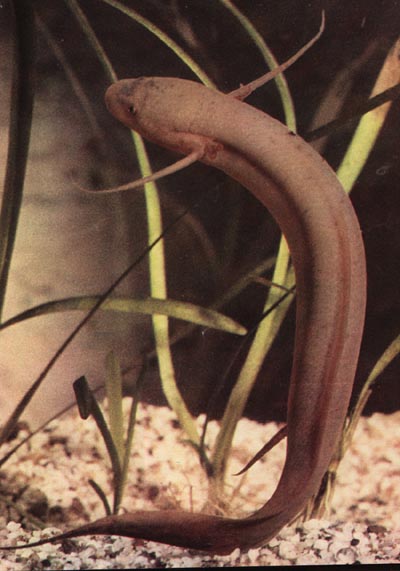
Photo courtesy of The Lungfish Website |

Photo courtesy of The Lungfish Website |
| Name: Slender African Lungfish |
| Scientific name: Protopterus annectens |
| Range: West & South Africa |
| Habitat: swamps and small rivers |
| Status: Not threatened |
| Diet in the wild: frogs and small fish |
| Diet in the zoo: krill |
| Location in the zoo: James R. Record Aquarium |
| Physical description: They range in size from 60 to 200 cm. The African lungfish has two lungs which enables them to breath when the water has dried up. The heart of the lungfish contains four separate chambers: both the atrium and the ventricle are partially divided. |
| General information: There are
four African lungfish species. The P.anncetens, however is the most
common in aquariums. Lungfish are carnivores and are best kept in their
own tank. They are considered to be fearless and they will attack almost
anything that moves, including the hands of humans. Lungfish are rarely
imported and they may be considered illegal in some states. The lungfish
can survive in almost any type of water conditions, as well as an area
that has a low supply of oxygen.
|
| Special anatomical, physiological or behavioral adaptations: Although there is very dry climate in Africa, the African lungish is able to survive drought by "hibernation". The African lungfish digs itself into a mud hole and curls up in a chamber that is lined with mucus and breaths out of the mouth. During this time the mud hardens and the lungfish remains there until the next rainfall. However, sometimes this can be deadly for the lungfish, because the urine can posion its body. When it is time for spawning, males are said to have breathing in the form of threadlike appendages. The females lay their eggs in dug-out holes, while the male guard the eggs with all his might. |
| Comments about the African lungfish of the Fort Worth
Zoo.
If you watch the lungfish for a while you will be able to see them rise to the top to get some oxygen. The African lungish is not very active and is best off when he is left alone. Also the African lungfish is able to survive in dry climate because it burries its self in mud. The African lungfish resides in the aquarium with smaller fish and is not too active. |
| Personal Observations:
By observing the slender African lungish I discovered that this fish is very aggresive and is best off left alone. The African lungfish seems to me to always be thinking of ways to escape from the tank or attack someone. This may seem crazy or bizarre but that is how I feel when I stare at it for a while.
Lungfish photograph courtesy of the
|
| Source Materials and Related Links:
Lungfish
at the Oregon Zoo
Ceratodus, The Australian Lungfish by Lionel Lambkin (this book
didn't have anything to do with African lungfish, however I did get a few
ideas from this book that is why I listed it.)
|
| Page author: LaShawnda Brown
shatapoo@hotmail.com |
WhoZoo Home Animal Index Fish Index |
Source List: